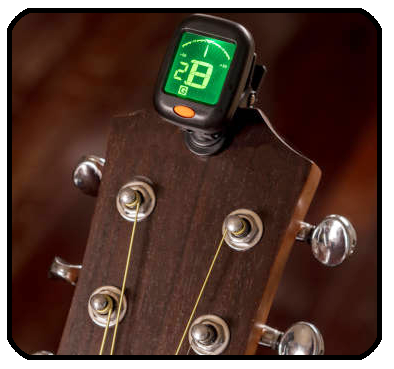Become familiar with how to change the strings and how to conduct general guitar care and maintenance on steel-string guitars. This lesson walks through each stage of changing strings with a step-by-step explanation.
STEEL-STRING ACOUSTIC – NEW STRINGS:
There are a few things that every guitarist should be able to do and one of them is to know when, and how to restring their acoustic guitar.
Many guitar players start playing on a steel-string acoustic, (generally due to their affordability). Luckily this type of guitar is one of the easiest guitar types to re-string and to maintain.
One of the most popular questions that new students will have is;
“How often should I change the strings on my Acoustic Guitar? “
That answer can vary slightly because it depends upon how much a guitarist plays. In general, the strings will loose a good deal of their smooth sound and their brightness after approximately 90 – 120 days.
When the strings sound very dull or if they feel dirty when playing melody lines, the strings should be replaced. Of course, this must be done sooner if one string breaks while riffing out on your favorite tune.
Also, keep in mind that excessive live playing, weather conditions, or even playing your guitar a lot outdoors can also affect string life.
Step 1 – Getting Started:
First, purchase a new package of guitar strings to replace your current worn strings. Normally, you would want to change all of your strings, but sometimes in a pinch (i.e., live on-stage), you might need to only replace one that broke. This article will cover a complete string change, (all 6 strings).
Find a nice level surface with plenty of room to work on. You don’t want your guitar to be scratched or scuffed so putting down something soft like a large towel or a blanket should be fine to protect your guitar.
Also, try to keep the head-stock of your guitar in a stable position. You should find a support for the back of the neck. When you will change strings, a support will keep the guitar steady resting in one place.
Several companies make Instrument Work Mat and Cradle Cube’s for proper Guitar Neck Support when changing the strings.
The cost of these work-mat /cradle kits will generally be well under $50 and I personally think that they are absolutely worth it to buy and own. Once purchased these work-mat kits will often last the buyer a life-time.

Step 2 – String Removal:
Begin by removing all of the old guitar strings. Start by reversing the tension off of each string at the tuning posts. Then cut each string off at the mid-point of the neck. The final step is to remove the string ends one by one from off of both the bridge, as well as, the tuning posts.
NOTE: A common myth circulated on the internet is that guitar strings should be replaced, “one at a time,” or the neck will warp. Not true!
This is false. In fact, for long term storage or air travel, all of the string tension should be backed off completely to prevent neck warp /damage.
Once all of the strings are removed, it is time to clean the neck and body.
Step 3 – Guitar Care and Maintenance:
After removing all of the guitar strings, you have the perfect opportunity to give all areas of your guitar important general cleaning and maintenance.
With the strings removed, you can dedicate time on cleaning; frets, neck and body of the guitar along with oiling the guitar fret-board, (if required).
Fret Cleaning: Clean the frets using super fine (.0000) grade steel wool. This is very soft steel wool that was designed for buffing untreated soft steel and for use on multi-coat finishes in between clear coats of varnish or polyurethane sealer.
Super fine (.0000) grade steel wool is gentle on exposed fret-board wood, (such as rosewood), and it is excellent for restoring the top surface of a guitar’s nickel frets, (or in rare cases stainless steel frets).
Wood Conditioning: The best way to condition any and all of the exposed wood surfaces of your guitar is by applying an organic almond oil onto those areas.
Lightly apply organic almond oil to any areas of exposed wood.
NOTE: there is no need to use any oil on areas that have been sealed from the factory with either a gloss or a satin finish lacquer.
Surface Cleaning: The best way to clean surfaces sealed by lacquers is with an automotive detailing spray. My favorite product for this job is, “Meguiar’s – Quik Detailer Mist and Wipe.”
Meguiar’s Mist and Wipe spray was designed for high-end show cars and has been industry recognized as one of the safest cleaners for any type of finish out there. The best part is that this product is not a wax, so it won’t build up on your guitars sealed surfaces over time. NOTE: Do not use on exposed wood.
Step 4 – Restringing the Guitar
Begin re-stringing from 6th string to the 1st string. At this time there is no need to tune to proper pitch. Once all of the strings are installed at a relaxed tension, you can start into doing a correct tuning of the guitar from the 6th to the 1st string.
Step 5 – Tuning the Guitar
It is helpful to have another guitar (or a piano) to tune your guitar to prior to pulling out an electronic tuner.
After your guitar is tuned to pitch, it is recommended that an electronic tuner be used on a daily basis to set and then to maintain your guitars proper tune. Clip on tuners are an excellent choice when it comes to being able to quickly tune up any guitar string into proper pitch.

CONCLUSION:
Learning to re-string your acoustic guitar may take some time and some practice to be able to get proficient at. However, the good news is that after every re-string that you work through, you’ll find that the job gets easier and easier.
Follow this posts step-by-step video lesson and use the various suggestions included within this “guitar string change breakdown” to eventually be able to master the skill of re-stringing your acoustic steel-string guitar.
